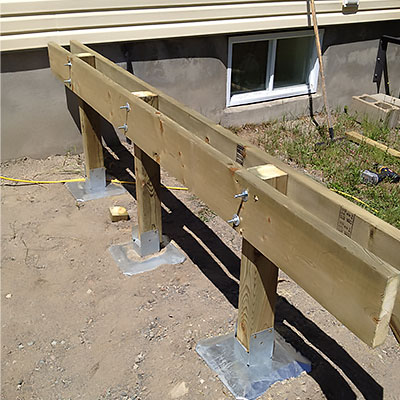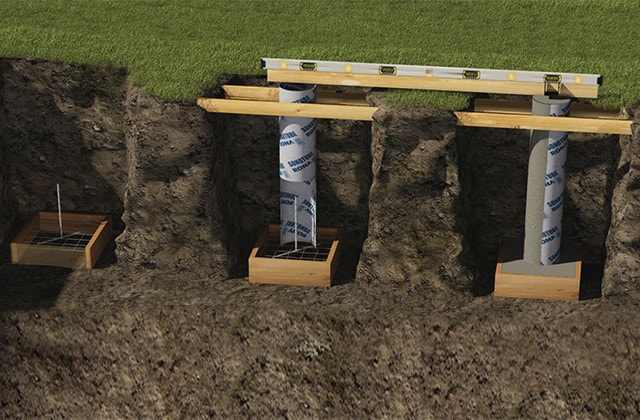Make Sure Security and Durability With Effectively Set Up Deck Grounds
Deck footings may not be the most glamorous facet of deck construction, but they play an essential duty in making certain security and durability. In this discussion, we will certainly discover the value of appropriate deck footings, factors to consider throughout installment, different types of grounds readily available, detailed setup guide, and upkeep pointers for making sure resilient footings.

Importance of Appropriate Deck Grounds
Why are effectively installed deck footings vital for the security and long life of your deck? The answer lies in the essential function that deck grounds play in sustaining the weight of the whole framework. Deck grounds are the structure on which the deck relaxes, moving the load from the deck to the ground. When footings are not properly installed, it can result in a variety of problems that endanger the security and long life of the deck.
Firstly, correctly installed deck footings distribute the weight of the deck evenly, avoiding any uneven settling or sinking. This is especially essential in areas with unstable soil, as it aids to minimize the threat of the deck changing or falling down. Furthermore, well-installed footings ensure that the deck remains level, avoiding any structural damage that can occur when a deck becomes irregular.
Second of all, effectively installed footings provide a solid anchor for the deck, stopping extreme activity and guide. This aids to keep the architectural stability of the deck, decreasing the danger of accidents or injuries. It also minimizes the wear and tear on the deck, allowing it to endure the aspects and routine use for a longer time period.
Variables to Take Into Consideration for Deck Ground Setup
When installing deck footings, there are numerous crucial factors to take into consideration for proper installation. These variables can significantly impact the security and long life of your deck. You require to determine the type of dirt on which the deck will certainly be built. Various dirt types have different load-bearing abilities, so it is important to perform a soil test to make sure the grounds can support the weight of the deck and its passengers. In addition, the location and design of the deck must be carefully prepared to prevent any kind of obstacles such as trees, utility lines, or underground pipelines. It is additionally essential to think about the neighborhood climate and weather, as these can influence the resilience of the footings. For example, areas with a high water table might require extra procedures to protect against water damage. The size and material of the footings need to be chosen based on the size and weight of the deck, as well as the regional structure codes and laws. By taking right into account these variables, you can guarantee the appropriate setup of deck grounds and enjoy a long-lasting and stable deck.
Kinds Of Deck Grounds to Select From
There are numerous various types of deck grounds available for you to pick from. Each type has its very own advantages and disadvantages, so it's important to consider your certain needs and the problems of your deck before making a choice.
One common type of deck ground is the concrete ground. This includes digging holes in the ground and putting concrete right into them to create a solid structure. Concrete grounds are resilient and offer outstanding stability, making them ideal for decks in areas with challenging soil problems or high wind tons.
Another option is the helical pier ground, which contains a steel shaft with helical plates that are screwed into the ground. These grounds fast to install and can be used in numerous dirt types, including sandy or clay dirts. They are additionally flexible, enabling very easy leveling of the deck.
Sonotube footings are one more preferred choice. These grounds are developed by placing a cardboard tube in a hole and filling it with concrete. Sonotube footings are fairly easy to install and offer adequate security for smaller decks or in areas with much less demanding dirt conditions.

When picking the sort of deck ground, it's crucial to consider factors such as soil problems, deck dimension and weight, neighborhood building regulations, and individual preferences. By choosing the suitable footing type, you can guarantee the stability and longevity of your deck.
Step-by-Step Overview for Putting Up Deck Footings

Determine the place: Start by marking the precise placement of each footing utilizing risks and string (Deck Footings). Think click over here now about any regional building regulations or policies pertaining to setback distances
Dig the openings: Make use of a post hole digger or an auger to dig the holes for the grounds. Usually, a depth of at least 36 inches is recommended for stability.
Level the holes: Make sure that all-time lows of the openings are degree (Deck Footings). This can be achieved by using a level or a straight board across the top of the holes
Add crushed rock: Location a layer of crushed rock at the end of each opening to boost water drainage and prevent the footing from sinking into the soil over time.
Insert the footing forms: Insert the footing forms into the openings, guaranteeing they are focused and degree. Usage risks to protect them in location.
Mix and put concrete: Comply with the directions on the concrete mix bag to prepare the concrete. Put the concrete right into the footing forms, filling them completely.
Smooth the surface: Use a trowel to smooth the surface area of the concrete and get rid of any kind of air pockets. Permit the concrete to heal according to the maker's directions.
Maintenance Tips for Lasting Deck Footings
Correct upkeep is vital for making sure the durability and stability of deck footings. By regularly inspecting and keeping your deck grounds, you can avoid damage and possible security dangers. One essential aspect of upkeep is to consistently look for any type of signs of wear and tear, such as cracks or activity in the footings. If you notice any kind of problems, it is very important to resolve them without delay to prevent further damages.
Normal cleaning is additionally check these guys out vital for maintaining deck grounds. Dust, debris, and plant life can build up around the grounds, which can lead to moisture accumulation and degeneration. Cleansing the grounds frequently, making use of a brush or a pressure washer, can assist protect against these issues and extend the life expectancy of your deck.
Along with cleansing, it is necessary to keep the area around the footings clear of any type of blockages. Stay clear of piling things against the footings or allowing plants to grow as well near to them. These obstructions can trap wetness and create the grounds to wear away over time.
Lastly, regular resealing of the footings is recommended to safeguard them from wetness and other environmental elements. Applying a water resistant sealant can help avoid water damage and extend the life expectancy of the footings.
Conclusion
In conclusion, proper installation of deck footings is crucial for guaranteeing stability and long life of your deck. Variables such as dirt kind, tons capability, and regional building regulations need to be considered when choosing the right kind of deck grounds. Adhering to a detailed guide for installation and regular upkeep will certainly assist to make sure the footings remain resilient and sturdy.
In this conversation, we Learn More will certainly check out the importance of proper deck grounds, variables to take into consideration throughout installment, various types of footings readily available, detailed installation guide, and upkeep suggestions for guaranteeing lasting footings. Deck grounds are the structure on which the deck rests, transferring the lots from the deck to the ground.One typical type of deck ground is the concrete footing. Insert the footing types: Insert the ground forms right into the holes, guaranteeing they are centered and degree.In conclusion, correct installation of deck grounds is important for ensuring security and longevity of your deck.